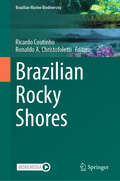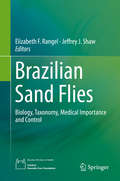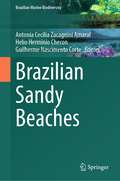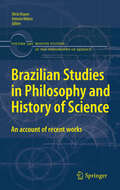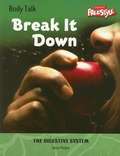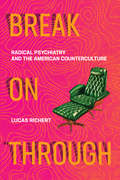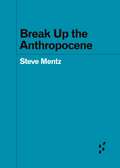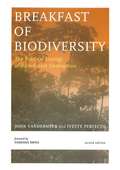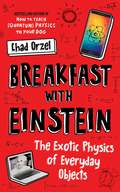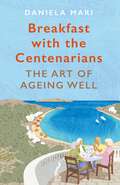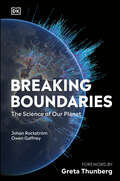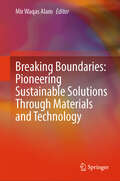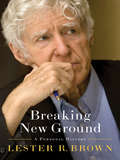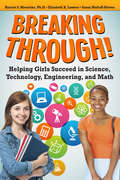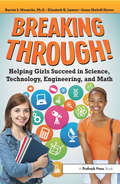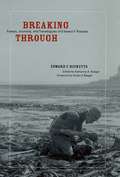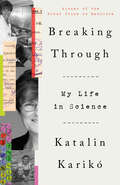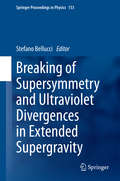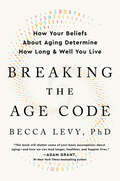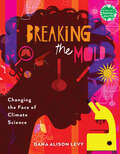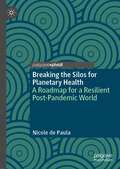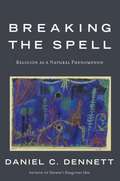- Table View
- List View
Brazilian Rocky Shores (Brazilian Marine Biodiversity)
by Ricardo Coutinho Ronaldo A. ChristofolettiRocky shores correspond to a very particular habitat in Brazil, which is concentrated in the Southeastern and Southern coasts. There are different types of substrata and seascapes that cause a high environmental heterogeneity responsible to host a high species biodiversity and a range of ecosystem services. Primary and secondary production, as well as structuring organisms and processes, differs from temperate areas.
Brazilian Sand Flies: Biology, Taxonomy, Medical Importance and Control
by Elizabeth F. Rangel Jeffrey J. ShawThis is the first English-language book dedicated to Brazilian sand flies and their medical importance. No other country has so many species of these haematophagous insects as Brazil and their diversity has reached an astonishing level. The book contains comprehensive chapters, written by Brazilian experts on their regional distribution, their ecology and their importance as vectors of pathogens and parasites. Methods for sampling, processing and preserving phlebotomines are reviewed as are perspectives on surveillance and leishmaniasis vector control. A novel classification is presented whose aim is to help investigators identify the species that they are working with more efficiently.
Brazilian Sandy Beaches (Brazilian Marine Biodiversity)
by Antonia Cecilia Zacagnini Amaral Helio Herminio Checon Guilherme Nascimento CorteMore than 4000 beaches distributed along the Brazilian coastline are one of the country's main assets. They harbor endemic and diverse biota and provide numerous goods and services essential to human populations. However, they are under increasing pressure, trapped between the impacts of climate change and human activities in the terrestrial and marine environment, and the knowledge about their environmental characteristics and biodiversity is still insufficient to ensure their preservation. This book is the first-ever comprehensive work about Brazil's sandy beaches addressing their physical, ecological, and social aspects. It was written by an interdisciplinary group of leading Brazilian researchers from different regions of the country and also had the contribution of a few international experts. The information synthesized in this book is accessible to anyone who wants to know more about Brazilian coastal biodiversity and represents a significant step towards conserving Brazilian sandy beaches, their biodiversity, and ecosystem services.
Brazilian Studies in Philosophy and History of Science: An account of recent works (Boston Studies in the Philosophy and History of Science #290)
by Décio Krause Antonio VideiraThis volume, The Brazilian Studies in the Philosophy and History of Science, is the first attempt to present to a general audience, works from Brazil on this subject. The included papers are original, covering a remarkable number of relevant topics of philosophy of science, logic and on the history of science. The Brazilian community has increased in the last years in quantity and in quality of the works, most of them being published in respectable international journals on the subject. The chapters of this volume are forwarded by a general introduction, which aims to sketch not only the contents of the chapters, but it is conceived as a historical and conceptual guide to the development of the field in Brazil. The introduction intends to be useful to the reader, and not only to the specialist, helping them to evaluate the increase in production of this country within the international context.
Break It Down: How Scientists Separate Mixtures
by Ashley Chase Jonathan CurleyNIMAC-sourced textbook
Break It Down: The Digestive System
by Steve ParkerTake a new look at the human body. Find out what happens to the food you eat as it makes its journey through your body. Using interesting photos and facts, this book will really make you think about your body and the amazing things that go on inside you every second. You'll never feel the same way about yourself!
Break On Through: Radical Psychiatry and the American Counterculture
by Lucas Richert“Antipsychiatry,” Esalen, psychedelics, and DSM III: Radical challenges to psychiatry and the conventional treatment of mental health in the 1970s.The upheavals of the 1960s gave way to a decade of disruptions in the 1970s, and among the rattled fixtures of American society was mainstream psychiatry. A “Radical Caucus” formed within the psychiatric profession and the “antipsychiatry” movement arose. Critics charged that the mental health establishment was complicit with the military-industrial complex, patients were released from mental institutions, and powerful antipsychotic drugs became available. Meanwhile, practitioners and patients experimented with new approaches to mental health, from primal screaming and the therapeutic use of psychedelics to a new reliance on quantification. In Break on Through, Lucas Richert investigates the radical challenges to psychiatry and to the conventional treatment of mental health that emerged in the 1970s and the lessons they offer for current debates.Drawing on archives and government documents, medical journals, and interviews, and interweaving references to pop (counter)culture into his account, Richert offers fascinating stories of the decade's radical mental health practices. He discusses anti–Vietnam War activism and the new diagnosis of post–traumatic stress disorder given to some veterans; the radical psychiatrists who fought the system (and each other); the entry of New Age–style therapies, including Esalen's Human Potential Movement, into the laissez-faire therapeutic marketplace of the 1970s; the development of DSM III; and the use of LSD, cannabis, and MDMA. Many of these issues have resonance today. Debates over medical marijuana and microdoses of psychedelics echo debates of the 1970s. With rising rates of such disorders as anxiety and depression, practitioners and patients continue to search for therapeutic breakthroughs.
Break Up the Anthropocene (Forerunners: Ideas First)
by Steve MentzTakes the singular eco-catastrophic &“Age of Man&” and redefines this epoch We live in a new world: the Anthropocene. The Age of Man is defined in many ways, and most dramatically through climate change, mass extinction, and human marks in the geological record. Ideas of the Anthropocene spill out from the geophysical sciences into the humanities, social sciences, the arts, and mainstream debates—but it&’s hard to know what the new coinage really means. Break Up the Anthropocene argues that this age should subvert imperial masculinity and industrial conquest by opening up the plural possibilities of Anthropocene debates of resilience, adaptation, and the struggle for environmental justice. Forerunners: Ideas First Short books of thought-in-process scholarship, where intense analysis, questioning, and speculation take the lead
Breakfast Of Biodiversity
by Vandana Shiva Ivette Perfecto John VandermeerThe continuing devastation of the world's tropical rain forest affects us all-spurring climate change, decimating biodiversity, and wrecking our environment's resiliency. Millions of worried people around the world want to do whatever it takes to save the forest that is left.But halting rain forest destruction means understanding what is driving it.In Breakfast of Biodiversity, John Vandermeer and Ivette Perfecto insightfully describe the ways in which such disparate factors as the international banking system, modern agricultural techniques, rain forest ecology, and the struggles of the poor interact to bring down the forest. They weave an alternative vision in which democracy, sustainable agriculture, and land security for the poor are at the center of the movement to save the tropical environment.
Breakfast with Einstein: The Exotic Physics of Everyday Objects
by Chad OrzelA Sunday Times Book of the Year From the author of the international bestseller How to Teach Quantum Physics to Your Dog Your humble alarm clock, digital cameras, the smell of coffee, the glow of a grill, fibre broadband, smoke detectors… all hold secrets about quantum physics. Beginning at sunrise, Chad Orzel reveals the extraordinary science that underpins the simplest activities we all do every day, from making toast to shopping online. It&’s all around us, the wonderful weirdness of quantum – you just have to know where to look.
Breakfast with Einstein: The Exotic Physics of Everyday Objects
by Chad OrzelYour alarm goes off, and you head to the kitchen to make yourself some toast and a cup of coffee. Little do you know, as you savor the aroma of the steam rising from your cup, that your ordinary morning routine depends on some of the weirdest phenomena ever discovered. The world of quantum physics is generally thought of as hopelessly esoteric. While classical physics gives us the laws governing why a ball rolls downhill, how a plane is able to fly, and so on, its quantum cousin gives us particles that are actually waves, "spooky" action at a distance, and Schrodinger's unlucky cat. But, believe it or not, even the most mundane of everyday activities is profoundly influenced by the abstract and exotic world of the quantum. In Breakfast with Einstein, Chad Orzel illuminates the strange phenomena lurking just beneath the surface of our ordinary lives by digging into the surprisingly complicated physics involved in his (and anyone's) morning routine. Orzel, author of How to Teach Quantum Physics to Your Dog, explores how quantum connects with everyday reality, and offers engaging, layperson-level explanations of the mind-bending ideas central to modern physics. From the sun, alarm clocks, and the red glow of a toaster's hot filaments (the glow that launched quantum mechanics) to the chemistry of food aroma, a typical day is rich with examples of quantum weirdness. Breakfast with Einstein reveals the hidden physics all around us, and after reading this book, your ordinary mornings will never seem quite as ordinary again.
Breakfast with the Centenarians: The Science of Ageing Well
by Daniela MariLearn the art of growing old from the supercentenarians living life to the fullest. It's said that life begins at 40—but that number is constantly revised upwards as we live longer and longer. With the number of centenarians having quadrupled in the last 30 years, more of us can now hope to reach the 100-year mark than ever before. But how can we navigate this journey with grace, dignity and style? In this charming and informative book, Daniela Mari, an Italian doctor caring for some of the oldest people on the planet, draws on her experiences as a renowned gerontologist to reveal the science behind a healthy, happy old age. It turns out that the world's centenarians can teach us a thing or two about ageing well. And the secrets are not always what you'd think. Informed by the latest medical studies and incredible stories of individual longevity, Mari shows how our lifestyles can far surpass the influence of our genetics and why a daily glass of liquor isn't the end of the world. From our sleeping habits and diet to the crucial importance of our passions and interests, this is the essential handbook for a fruitful and fulfilling old age.
Breaking Boundaries
by Johan Rockstrom Owen GaffneyAn accessible summary of the planetary emergency and how to turn things around, from authors whose work is the focus of a new Netflix documentary narrated by David Attenborough.On the brink of a critical moment in human history, this book presents a vision of &“planetary stewardship&” – a rethinking of our relationship with our planet – and plots a new course for our future. The authors, whose work is the subject of a new documentary due to air on Netflix summer 2021, reveal the full scale of the planetary emergency we face – but also how we can stabilize Earth&’s life support system. The necessary change is within our power, if we act now. In 2009, scientists identified nine planetary boundaries that keep Earth stable, ranging from biodiversity to ozone. Beyond these boundaries lurk tipping points. In order to stop short of these tipping points, the 2020s must see the fastest economic transition in history. This book demonstrates how societies are reaching positive tipping points that make this transition possible: groups such as the schoolchildren led by Greta Thunberg demand political action; countries are committing to eliminating greenhouse gas emissions; and one tipping point has even already passed – the price of clean energy has dropped below that of fossil fuels. The story is accompanied by unique images of Earth produced by Globaïa, the world&’s leading visualizers of human impact.
Breaking Boundaries: Pioneering Sustainable Solutions Through Materials and Technology
by Mir Waqas AlamThis book explores sustainable innovation by delving into advanced materials science and technology. Each chapter reveals the transformative potential of sustainable solutions, from groundbreaking advancements in nanomaterials to eco-friendly manufacturing practices. This book offers a captivating glimpse into the potential future of sustainability, appealing to experienced researchers, budding innovators, and those with a general interest in the topic. Also, this book provides valuable insights into recent developments in materials science and technology, catering to academics, engineers, and policymakers. It aims to promote collaboration across many disciplines and encourage innovation to speed up the development of sustainable solutions that will have a long-lasting positive effect on future generations.
Breaking New Ground: A Personal History
by Lester R. BrownAn inspirational memoir tracing Lester Brown's life from a small-farm childhood to leadership as a global environmental activist. Lester R. Brown, whom the Washington Post praised as "one of the world's most influential thinkers," built his understanding of global environmental issues from the ground up. Brown spent his childhood working on the family's small farm. His entrepreneurial skills surfaced early. Even while excelling in school, he launched with his younger brother a tomato-growing operation that by 1958 was producing 1.5 million pounds of tomatoes. Later, at the U.S. Department of Agriculture, Brown emphasized the need for systemic thinking. In 1963 he did the first global food supply and demand projections to the end of the century. While on a brief assignment in India in 1965, he pieced together the clues that led him to sound the alarm on an impending famine there. His urgent warning to the U.S. and Indian governments set in motion the largest food rescue effort in history, helping to save millions of lives. This experience led India to adopt new agricultural practices, which he helped to shape. Brown went on to advise governments internationally and to found the Worldwatch and Earth Policy institutes, two major nonprofit environmental research organizations. Both brilliant and articulate, through his many books he has brought to the fore the interconnections among such issues as overpopulation, climate change, and water shortages and their effect on food security. His 1995 book, Who Will Feed China?, led to a broad restructuring of China's agricultural policy. Never one to focus only on the problem, Brown always proposes pragmatic, employable solutions to stave off the unfolding ecological crises that endanger our future.
Breaking Through!: Helping Girls Succeed in Science, Technology, Engineering, and Math
by Harriet Mosatche Elizabeth Lawner Susan Matloff-NievesEven with increased pressure to involve more girls in STEM areas in education, parents are often left wondering what they can do to encourage their daughter's love of science, math, and technology from fading. In Breaking Through! Helping Girls Succeed in Science, Technology, Engineering, and Math, topics ranging from how role models can make a difference to finding non-stereotypical toys and taking trips that inspire STEM discovery and engagement are illustrated with research evidence and real-life examples from girls and women. Regardless of a daughter's age (from birth to young adulthood), parents will find tips they can immediately use to help combat the gender imbalance in STEM areas. Whether they need to advocate for gender-neutral, STEM-enriched classrooms or want to encourage creative problem-solving and persistence in their daughters, readers will find ideas to take action to help the girls in their lives break through the barriers and achieve success in STEM.
Breaking Through!: Helping Girls Succeed in Science, Technology, Engineering, and Math
by Harriet S. Mosatche Elizabeth Lawner Susan Matloff-NievesEven with increased pressure to involve more girls in STEM areas in education, parents are often left wondering what they can do to keep their daughter's love of science, math, and technology from fading. In Breaking Through! Helping Girls Succeed in Science, Technology, Engineering, and Math, topics ranging from how role models can make a difference to finding nonstereotypical toys and taking trips that inspire STEM discovery and engagement are illustrated with research evidence and real-life examples from girls and women. Regardless of a daughter's age (from birth to young adulthood), parents will find tips they can immediately use to help combat the gender imbalance in STEM areas. Whether they need to advocate for gender-neutral, STEM-enriched classrooms or want to encourage creative problem solving and persistence in their daughters, readers will find ideas to take action to help the girls in their lives break through the barriers and achieve success in STEM.2017 NAGC Book of the Year Award Winner
Breaking Through: Essays, Journals, and Travelogues of Edward F. Ricketts
by Edward F. RickettsThis unprecedented collection, featuring previously unpublished pieces as well as others available for the first time in their original form, reflects the wide scope of Ricketts's scientific, philosophical, and literary interests during the years he lived and worked on Cannery Row in Monterey, California.
Breaking Through: My Life in Science
by Katalin KarikóA powerful memoir from Katalin Karikó, winner of the 2023 Nobel Prize in Physiology or Medicine, whose decades-long research led to the COVID-19 vaccines &“Katalin Karikó&’s story is an inspiration.&”—Bill Gates&“Riveting . . . a true story of a brilliant biochemist who never gave up or gave in.&”—Bonnie Garmus, author of Lessons in ChemistryA KIRKUS REVIEWS BEST BOOK OF THE YEARKatalin Karikó has had an unlikely journey. The daughter of a butcher in postwar communist Hungary, Karikó grew up in an adobe home that lacked running water, and her family grew their own vegetables. She saw the wonders of nature all around her and was determined to become a scientist. That determination eventually brought her to the United States, where she arrived as a postdoctoral fellow in 1985 with $1,200 sewn into her toddler&’s teddy bear and a dream to remake medicine. Karikó worked in obscurity, battled cockroaches in a windowless lab, and faced outright derision and even deportation threats from her bosses and colleagues. She balked as prestigious research institutions increasingly conflated science and money. Despite setbacks, she never wavered in her belief that an ephemeral and underappreciated molecule called messenger RNA could change the world. Karikó believed that someday mRNA would transform ordinary cells into tiny factories capable of producing their own medicines on demand. She sacrificed nearly everything for this dream, but the obstacles she faced only motivated her, and eventually she succeeded.Karikó&’s three-decade-long investigation into mRNA would lead to a staggering achievement: vaccines that protected millions of people from the most dire consequences of COVID-19. These vaccines are just the beginning of mRNA&’s potential. Today, the medical community eagerly awaits more mRNA vaccines—for the flu, HIV, and other emerging infectious diseases.Breaking Through isn&’t just the story of an extraordinary woman. It&’s an indictment of closed-minded thinking and a testament to one woman&’s commitment to laboring intensely in obscurity—knowing she might never be recognized in a culture that is driven by prestige, power, and privilege—because she believed her work would save lives.
Breaking of Supersymmetry and Ultraviolet Divergences in Extended Supergravity: Proceedings of the INFN-Laboratori Nazionali di Frascati School 2013 (Springer Proceedings in Physics #153)
by Stefano BellucciThis is the seventh volume in a series on the general topics of supersymmetry, supergravity, black objects (including black holes) and the attractor mechanism. The present volume is based on lectures held in March 2013 at the INFN-Laboratori Nazionali di Frascati during the Breaking of supersymmetry and Ultraviolet Divergences in extended Supergravity Workshop (BUDS 2013), organized by Stefano Bellucci, with the participation of prestigious speakers including P. Aschieri, E. Bergshoeff, M. Cederwall, T. Dennen, P. Di Vecchia, S. Ferrara, R. Kallosh, A. Karlsson, M. Koehn, B. Ovrut, A. Van Proeyen, G. Ruppeiner. Special attention is devoted to discussing topics related to the cancellation of ultraviolet divergences in extended supergravity and Born-Infeld-like actions. All talks were followed by extensive discussions and subsequent reworking of the various contributions a feature which is reflected in the unique "flavor" of this volume.
Breaking the Age Code: How Your Beliefs About Aging Determine How Long and Well You Live
by Becca Levy PhDYale professor and leading expert on the psychology of successful aging, Dr. Becca Levy, draws on her ground-breaking research to show how age beliefs can be improved so they benefit all aspects of the aging process, including the way genes operate and the extension of life expectancy by 7.5 years.The often-surprising results of Levy’s science offer stunning revelations about the mind-body connection. She demonstrates that many health problems formerly considered to be entirely due to the aging process, such as memory loss, hearing decline, and cardiovascular events, are instead influenced by the negative age beliefs that dominate in the US and other ageist countries. It’s time for all of us to rethink aging and Breaking the Age Code shows us how to do just that.Based on her innovative research, stories that range from pop culture to the corporate boardroom, and her own life, Levy shows how age beliefs shape all aspects of our lives. She also presents a variety of fascinating people who have benefited from positive age beliefs as well as an entire town that has flourished with these beliefs.Breaking the Age Code is a landmark work, presenting not only easy-to-follow techniques for improving age beliefs so they can contribute to successful aging, but also a blueprint to reduce structural ageism for lasting change and an age-just society.
Breaking the Mold: Changing the Face of Climate Science (Books for a Better Earth)
by Dana Alison LevySixteen scientists. Protecting our planet. Making science more equitable.Scientists who collect microbes from surfers' skin, who use radar sensors to gather data miles away, who combat inequality by pushing for cleaner air policies. Each with their own story, all working to make life better for future generations.Celebrated author Dana Alison Levy profiles 16 people, all studying different elements of the earth&’s landscape, animals, and climate, who defy stereotypes of who can be a scientist. From analytical chemists to volcanologists, from global experts to recent graduates, these scientists share what they were like as young people, how they got where they are now, and what they—and the rest of us—can do to help the planet.Based on extensive interviews and featuring infographics and personal photos, Breaking the Mold offers a snapshot of the people and organizations fighting to make science more equitable. Back matter includes advice for readers interested in science careers, DIY projects, paths to community involvement, and more.Books for a Better Earth are designed to inspire children to become active, knowledgeable participants in caring for the planet they live on.
Breaking the Ring
by John BarronThe bizarre case of the espionage operation of the John Walker family and the U.S. government's hunt for the spy and his accomplices.
Breaking the Silos for Planetary Health: A Roadmap for a Resilient Post-Pandemic World
by Nicole de PaulaThis book translates the latest theoretical perspectives on the emerging field of Planetary Health Studies into the practical reality of global political decision makers. It builds on the scientific data on the impacts of environmental change on human health to propose practical methods for operationalizing planetary health. The book maps opportunities for decision makers to break institutional silos and engage with bottom-up approaches that can transform planetary health from a global idea into a local reality. The analysis frames human health in the Anthropocene, an era in which humans have become the most powerful force affecting global ecosystems, and reveals new existential risks for humankind.Departing from ongoing multilateral efforts to promote sustainability, the author’s analysis places the agenda of planetary health on the desk of political decision makers, still underrepresented at planetary health gatherings. Given the pressing need to implement sustainable development policies, the book presents planetary health as an overarching framework for global policy targets, notably the UN Sustainable Development Goals, the Paris Agreement on Climate Change, and the post-2020 biodiversity framework under the UN Convention on Biological Diversity. The book is timely in offering a concrete road map for practitioners and researchers interested in transforming the concept of planetary health into reality. With a collection of success stories, the analysis dwells on tools for community engagement, opportunities for health professionals training, gender empowerment, digital health, and innovative ways to enhance human well-being on a changing planet.
Breaking the Spell
by Daniel C. DennettFew forces in the world are as potent as religion: it comforts people in their suffering and inspires them to both magnificent and terrible deeds. In this provocative and timely book, Daniel C. Dennett seeks to uncover the origins of religion and discusses how and why different faiths have shaped so many lives, whether religion is an addiction or a genuine human need, and even whether it is good for our health. Arguing passionately for the need to understand this multifaceted phenomenon, Breaking the Spell offers a truly original - and comprehensive - explanation for faith.
